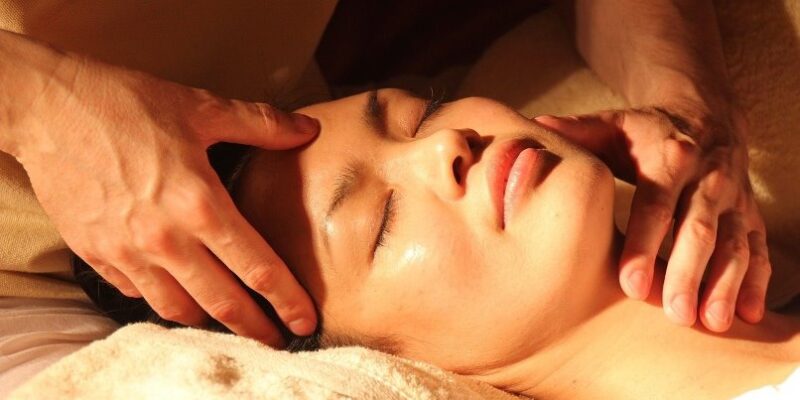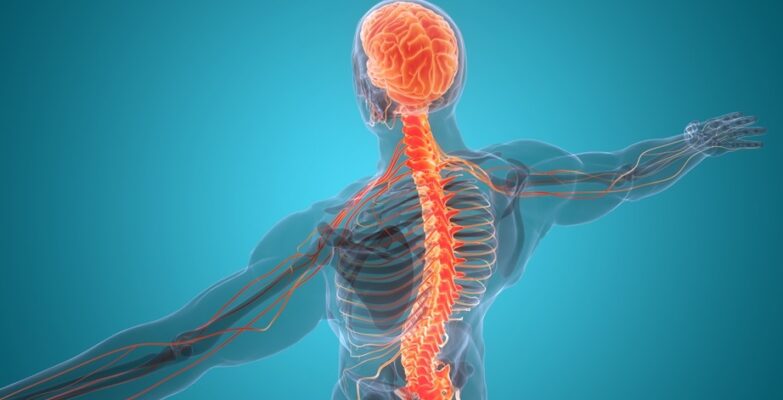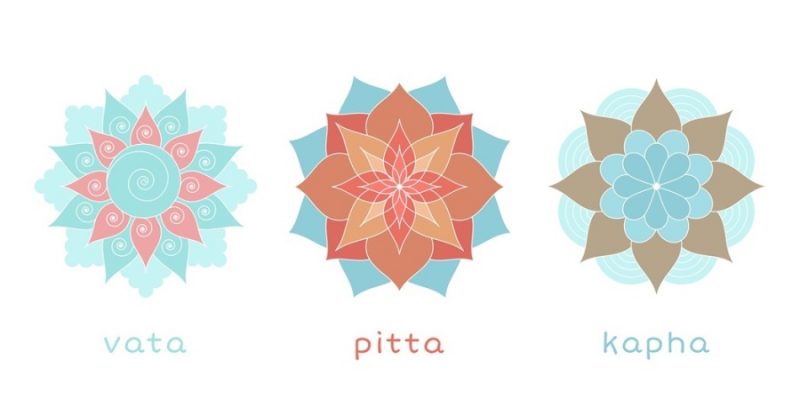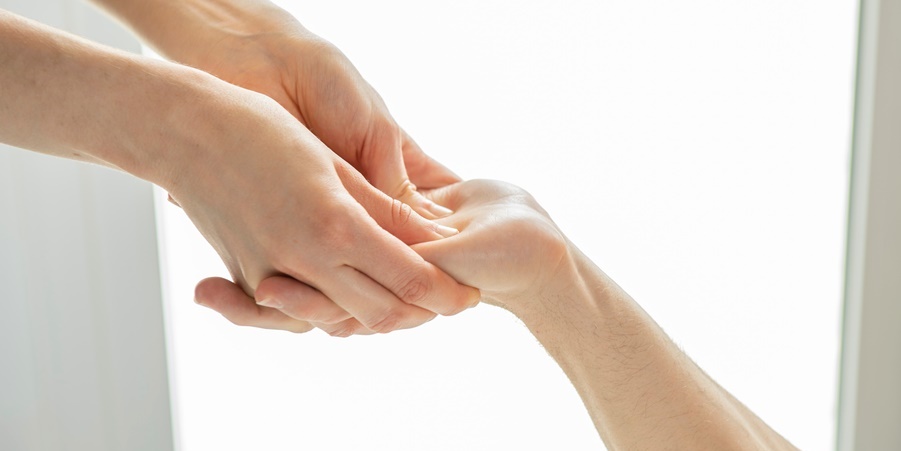
Each of the major Prana Nadis has a specific ending point, typically related to one of the so-called Gates of the Body, the latter being the orifices or “doors” of the body, such as the ears, nose, mouth, eyes, and so on.

The termination points of the Nadi pathways are also related to certain Marma Points, which are the pranic Vital Points known from Ayurveda, but likewise playing an important role in Yoga.
The idea of Marma Points is thought to have originated from the ancient Indian martial arts, where they were taught as certain Bindu i.e. “lethal points” in order to neutralize an adversary (or protect those points on one’s body of being attacked by an adversary).
Nevertheless, these Vital Points were later also used for therapeutic purposes in Ayurveda and Yoga, because an impairment or blockage of these Marma Points (which can occur otherwise than only in combat) can lead to discomforts or diseases. As such, treating them can alleviate or heal certain health conditions.
In any case, before we discuss the several Marma Points and their correspondence with certain Nadi ending points, below first a quick overview in a chart that lists the correlations of major Nadis, Marma Points, and therapeutic indications.
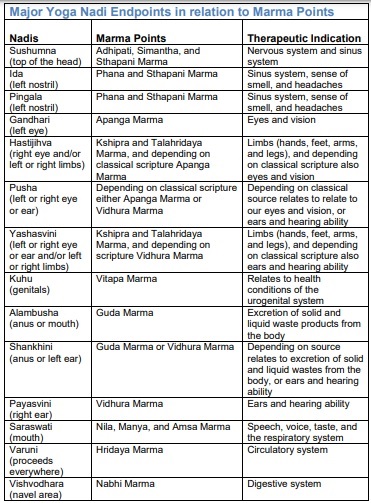
Adhipati Marma
Adhipati Marma is a single point located at the top of the skull (fontanel) and corresponds with the tenth gate (Brahmarandhra) and the Sahasrara Chakra (Crown Chakra), being the endpoint of Sushumna Nadi.
Injury of Adhipati Marma is related to health conditions of the nervous system and sinus system.
Simantha Marma
Simantha Marma is a single point located on the skull, more at the back of the head and also associated with the termination area of Sushumna Nadi.
Sthapani Marma
Sthapani Marma is a single point, also called Ajna Marma because it’s located between the eyebrows at the location of the “Third Eye” i.e. Ajna Chakra. Sthapani corresponds with the broader termination area of Sushumna Nadi.
This Marma Point also represents the confluence of Ida, Pingala, and Sushumna Nadi in the upper region of the body, which is called the Mukta Triveni.
Injury or impairment of Sthapani Marma is related to health conditions of the nervous system.
Phana Marma
Phana Marma is located just up the base of the nose, inside the nasal passages, before the opening of the nostrils.
Phana corresponds with the endpoints of Ida Nadi on the left side of the nose, and to the endpoint of Pingala Nadi on the right side of the nose.
The therapeutic indications relate to the sinus system, sense of smell, and headaches.
Apanga Marma
The two Apanga Marmas are located at the outer corners of the eyes. Depending on which Nadis one considers to have their ending points at the right eye (there’s debate about this and the classical scriptures contradict each other) the right Apanga point would correspond with either Pusha Nadi or Hastijihva Nadi.
However, about the left Apanga Marma there’s more consensus, relating it to the endpoint of Gandhari Nadi.
The therapeutic indications of Apanga Marma relate to our eyes and vision.
Vidhura Marma
Vidhura Marma (Vidhur) is located at the back of the underside of the ear, and corresponds to Nadis that have their ending points in the ears. As there’s debate in the scriptures about which Nadis end in which ear, there could be several options.
The left Vidhura Marma could relate to Yashaswini Nadi or Shankhini Nadi (Sankini), and the right Vidhura Marma could correspond to the ending points of Pusha Nadi (Pusa) or Payaswini Nadi.
The therapeutic indications of Vidhura Marma relate to our ears and hearing ability.
Kshipra Marma and Talahridaya Marma
Kshipra Marma is located in both hands (in the palm of the hand in the junction of thumb and index finger) and both feet (on top of the feet between the big toe and long toe). As such there are four Kshipra Marma points.

Talahridaya Marma is located in both hands (in the middle of the palms of the hands) and both feet (in the middle on the top of the feet). As such there are four Talahridaya Marma points.
Both Marma Points relate to health conditions associated with the hands and feet, and in a more general sense with issues concerning the limbs (arms and legs).
Depending on which Nadis are associated with having their ending points at the left or right hands and/or feet (the scriptures do not agree on this), different options are possible as for the correlations with the Marmas.
In any case, generally Hastijihva Nadi and Yashaswini Nadi (Yahsasvati) are thought to correspond with these Marma Points, either on the right or left side of the body.
Guda Marma
Guda Marma is commonly thought to correspond with the endpoint of Alambusha Nadi.
The region of Guda Marma is the anus and Muladhara Chakra (Root Chakra), and relates to therapeutic indications for the excretory system. It’s said to be located at the tip of the tailbone (coccyx).
Nevertheless, Guda Marma could also relate to Shankhini Nadi, of which some classical sources locate its ending point in the anus.
Treating Guda Marma supports healthy functioning of the rectum, and proper excretion of solid and liquid waste products from the body.
Vitapa Marma
Vitapa Marma corresponds with the endpoint of Kuhu Nadi. Vitapa Marma is located in the groin (on both thighs of the legs), and also relates to the Svadhisthana Chakra (Sacral Chakra)
Therapeutic indications include inguinal hernia, impotency, semen quality, infertility, and in general relates to health conditions of the urogenital system of both men and women (reproductive and urinary organs).
Kukundara Marma
Kukundara Marma is located on both sides of the spinal column in the gluteal area (buttocks). Like Vitapa Marma it corresponds with the endpoint of Kuhu Nadi.
Therapeutic indications include sciatica, dysfunctions of the lower limbs, and in general relates to health conditions of all lower parts of the body.
Nila and Manya Marma
Nila Marma (Neela Marma) and Manya Marma are often taken together and are located in the neck region, on either side of the trachea (windpipe). They correspond with the termination area of Saraswati Nadi (Sarasvati), and are also related to Vishuddha Chakra (Throat Chakra).
These Marma Points have therapeutic indications that are mostly related to speech, voice, taste, and the respiratory system.
Amsa Marma
Amsa Marma (Ansa) is located on either side of the spine at the upper back between the shoulder and neck on the trapezius. Amsa is associated with the termination area of Saraswati Nadi, just like Nila and Manya Marma.
Amsa’s therapeutic indications are mostly related to impairment of the shoulders and arms.
Hridaya Marma
Hridaya Marma corresponds with one of the endpoints of Varuna Nadi, is located in the heart region (in the chest cavity between breasts and near opening of the stomach), and relates to the Anahata Chakra (Heart Chakra). Mind that Varuna Nadi has many endpoints as it proceeds and ends at many different locations across the entire body.
Hridaya Marma has therapeutic indications that are mostly related to the circulatory system.
Nabhi Marma
Nabhi Marma (Navel Marma) corresponds with the endpoint of Vishvodhara Nadi. Nabhi Marma relates to the navel area and Manipura Chakra (Navel Chakra i.e. Solar Plexus Chakra). It’s located between the large and small intestine in the abdominal area.
Nabhi Marma has therapeutic indications that are related to the digestive system.











